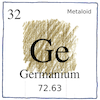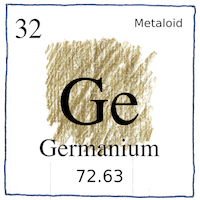Freiberg—Clemens Winkler
elements

|
Germanium
Fifteen years earlier, Dmitri Mendeleev, for his periodic table, predicted elements next to cadmium, ekacadmium, and next to silicon, ekasilicon. Then professor Clemens Winkler was asked to analyze a new mineral found in the Himmelsfürst mine near Freiberg called argyrodite as it was known to contain silver. Winkler found that argyrodite contained silver, sulfur, a little iron, and about six to seven percent of a previously unknown element. Mendeleev thought it might be ekacadmium. Julius Lothar Meyer thought it was ekasilicon. Eventually, Winkler isolated enough of it to determine its physical properties. Mendeleev had predicted the atomic mass of ekasilison of 72; germanium’s atomic mass is 72.61; confirming the concept of element periodicity.
Atomic number 32
Germanium is a semiconductor. Electronics built on it instead of silicon are faster. Computer chips, LEDs, photovoltaic cells, phosphors for fluorescent lights. Germanium oxide in optics for high index of refraction and low optical dispersion. Camera and microscope lenses, optical fibers, rewritable DVDs, night goggles. Germanium crystals identify radiation sources for airport security and gamma spectroscopy.
Angularium
Winkler thought he’d name the element Neptunium because Neptune’s existence was predicted before it was found; however, the name was already given to an alleged element found in Tantalite. Some scientists objected to Germanium because it sounds like “geranium,” so Raymond joked that it should be called Angularium, its angular nature causing dispute and Winkel meaning angle in German, like Winkler, but Mendeleyev himself wrote Winkler that Germanium was a fine name.
Properties
Sensitive and fast. He’ll catch on quickly and toss it back. Reflection, refraction. His mind’s acute; ready for action.



Clemens Winkler’s name for his own country was not “Germany,” but “Deutschland.” According to Peter van der Krogt, Winkler named germanium after the Roman’s names for the area they occupied, west and south of the Rhine, Lower and Upper Germania, and the area east of the Rhine, Greater Germania, whose people defeated the Romans in AD 9, establishing the Rhine and the Danube as the northern border of the Roman Empire.
See also in The book of science:
Readings in wikipedia:
Other readings: